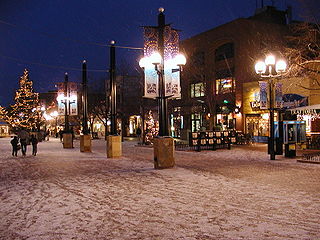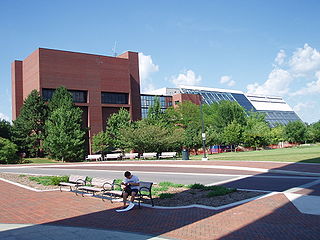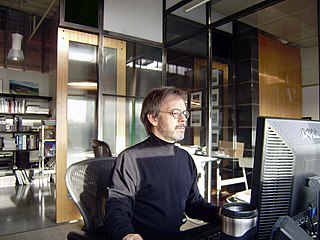
Landscape architecture is the design of outdoor areas, landmarks, and structures to achieve environmental, social-behavioural, or aesthetic outcomes. It involves the systematic design and general engineering of various structures for construction and human use, investigation of existing social, ecological, and soil conditions and processes in the landscape, and the design of other interventions that will produce desired outcomes. The scope of the profession is broad and can be subdivided into several sub-categories including professional or licensed landscape architects who are regulated by governmental agencies and possess the expertise to design a wide range of structures and landforms for human use; landscape design which is not a licensed profession; site planning; stormwater management; erosion control; environmental restoration; parks, recreation and urban planning; visual resource management; green infrastructure planning and provision; and private estate and residence landscape master planning and design; all at varying scales of design, planning and management. A practitioner in the profession of landscape architecture may be called a landscape architect, however in jurisdictions where professional licenses are required it is often only those who possess a landscape architect license who can be called a landscape architect.
A charrette, often Anglicized to charette or charet and sometimes called a design charrette, is an intense period of design or planning activity.

1 Spadina Crescent, also known as the Daniels Building, is an academic building home to the John H. Daniels Faculty of Architecture, Landscape, and Design at the University of Toronto in Toronto, Ontario, Canada. The building is situated in the centre of a roundabout of Spadina Avenue, north of College Street. Its location provides a picturesque vista looking north up Spadina Avenue; it is an axial view terminus for Spadina Avenue.

Hideo Sasaki was a Japanese American landscape architect.
Grant Richard Jones is an American landscape architect, poet, and founding principal of the Seattle firm Jones & Jones Architects, Landscape Architects and Planners. In more than four decades of practice, his work in ecological design has garnered widespread recognition for its broad-based and singular approach, one that is centered on giving voice to the land and its communities. Called the “poet laureate of landscape architecture” Jones's poetry informs his designs.
Edward Durell Stone Jr. was an American landscape architect.
Bruce D. Judd, FAIA, is a historic preservation architect based in Seaside, Florida, and San Francisco, California. He is a principal in the Bruce Judd Consulting Group in Seaside and a Consulting Founding Principal at the Architectural Resources Group in San Francisco. His projects have included surveying the historic African American community of Mound Bayou, Mississippi resulting in its being listed in the National Register of Historic Places. He has also consulted on the restoration of the Alamo Mission in San Antonio, Texas. Judd has directed more than 300 planning, rehabilitation, and expansion projects for architecturally significant buildings throughout the west and is a nationally recognized expert in his field. He has led rehabilitation and new construction projects for library, cultural, and performing arts facilities. He has also directed various high-profile projects including: master plan and restoration of the Hotel Del Coronado; repair and restoration of the San Francisco Conservatory of Flowers in Golden Gate Park, which received a National AIA Honor Award; master planning and seismic retrofit of the block-square Beaux-Arts style Pasadena City Hall which received LEED Gold certification; and rehabilitation of the historic Linde Robinson Laboratory for the Center for Global Environmental Ecology at Caltech in Pasadena, the first laboratory in a historic building to receive a LEED Platinum certification. Judd meets The Secretary of the Interior's Historic Preservation Professional Qualifications Standards in Architecture, Historic Architecture, Architectural History, and History.

The R. Wayne Estopinal College of Architecture and Planning, also known as CAP, is an academic college of Ball State University in Muncie, Indiana offering degrees in Architecture, Landscape Architecture, Urban Planning, Historic Preservation, Urban Design, Construction Management, and Interior Design, and is Indiana's only state-assisted Architecture school.

Alan B. Ford, FAIA, is an American architect and author best known for his work on K-12 sustainable schools.

Eldridge Hirst Lovelace was a city planner and author who prepared comprehensive plans for many large US cities.
Design Workshop is an international landscape architecture, land planning, urban design and strategic services firm that began in 1969. The firm was named ASLA's Firm of the Year in 2008 for its work in new communities, urban centers, resorts, public parks, golf courses and residences.
EDSA, Inc. is a planning, landscape architecture, and urban design firm founded in 1960. The company is headquartered in Fort Lauderdale, Florida with offices in Orlando, Florida; Raleigh, North Carolina; New York, New York; Baltimore, Maryland; and Shanghai, China. There are more than 150 employees who represent EDSA and come from a varied range of cultural and ethnic distinctiveness with origins from more than 25 different countries. In addition, their portfolio spans a global range of more than 500 projects in over 100 countries. The firm has been referred to as one of the leading landscape architecture companies in the world.EDSA also considers itself a steward of the land, according to the website, and places sustainability at the forefront of its planning and design efforts.

Elizabeth Wright Ingraham was an American architect and educator. A granddaughter of American architect Frank Lloyd Wright, she studied under his tutelage at his Taliesin studio at age 15. She later established an architect's practice in Colorado Springs, Colorado, with her husband, Gordon Ingraham, which adhered to Wright's architectural styles. In 1970 she formed her own architectural firm, Elizabeth Wright Ingraham and Associates, which she led until her retirement in 2007. She is credited with the design of approximately 150 buildings in Colorado Springs and other western locales. She also founded and directed the Wright-Ingraham Institute, which invites students and visiting faculty to conferences and workshops on environmental issues. She was posthumously inducted into the Colorado Women's Hall of Fame in 2014.
Jane Silverstein Ries (1909–2005), also known professionally as Julia Jane Silverstein, was an American landscape architect who was the first woman licensed in Colorado as a professional landscape architect. For her landscape work as well as her efforts to preserve and restore historical sites, she was inducted into the Colorado Women's Hall of Fame and a foundation was established in her name that awards scholarships in her field and supports an annual lecture series.
Susan A. Maxman is an American architect who founded a firm called Susan Maxman Architects in 1985, which she expanded to Susan Maxman & Partners Ltd in 1995. Her firm is associated with a large number of projects involving a wide spectrum of architectural services, including design of old and new buildings, restoration and rehabilitation works, master and site planning, feasibility reports, programming, historic preservation, and interior design. She was the first woman elected as president of the American Institute of Architects in 1992. Her expertise in adoption of the "principles of sustainable design" in her projects has received national appreciation, and in 2011 Maxman was nominated by President Barack Obama to the Board of Directors of the National Institute of Building Sciences.
EDAW was an international landscape architecture, urban and environmental design firm that operated from 1939 until 2009. Starting in San Francisco, the firm grew to become the most commercially successful and well-known landscape architecture and urbanism firm in the world, which at its peak had 32 offices worldwide. EDAW lead many landscape architecture, land planning and master planning projects, developing a reputation as an early innovator in sustainable urban development and multidisciplinary design.

FORREC Ltd. designs and plans theme parks, water parks, resorts, retail and mixed use developments and visitor attractions around the world. FORREC's clients include Universal Studios, LEGOLAND, Nickelodeon, BBC Worldwide and Six Flags as well as international companies like China's Wanda Group and Chimelong Group, Dubai Holdings, Dubai Parks & Resorts, Meraas Leisure and Entertainment LLC, Singapore Tourism Board and Khazanah Nasional Berhad. FORREC began as a landscape architecture firm in Canada in 1984 and has since added architecture, interior design and graphics disciplines.
Urban Design Associates is an international urban design and architecture firm headquartered in Pittsburgh, Pennsylvania, United States.

Sasaki is a design firm specializing in Architecture, Interior Design, Urban Design, Space Planning, Landscape Architecture, Ecology, Civil Engineering, and Place Branding. The firm is headquartered in Boston, Massachusetts, but practices on an international scale, with offices in Shanghai, and Denver, Colorado, and clients and projects globally.

Herbert R. Schaal is an American landscape architect, educator, and firm leader notable for the broad range and diversity of his projects, including regional studies, national parks, corporate and university campuses, site planning, botanical gardens, downtowns, highways, cemeteries, and public and private gardens. Schaal is one of the first landscape architects to design children's gardens, beginning in the 1990s with Gateway Elementary, Gateway Middle, and Gateway Michael Elementary school grounds in St. Louis, Missouri, the Hershey Children's Garden at the Cleveland Botanical Gardens, and Red Butte Garden and Arboretum.









